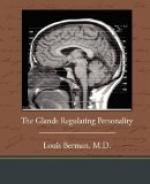After the second year, the thymus begins to shrink. That is to say, officially its involution begins. Careful dissection will demonstrate some thymus tissue even in a normal subject up to the fourteenth year. This refers to the average normal, for the large thymus may continue large and grow larger after the second year in the type of individual designated in a preceding chapter as the thymocentric.
If the thymus retrogresses after the second year, what takes its place as a brake upon the forward driving impulses of the other endocrines? We have every reason for assigning that role to the pineal. It performs its service mainly, in all probability, by inhibiting the sex stimulating effect of light playing upon the skin. Since it is especially a sex gland inhibitor, the thyroid and pituitary become freer to exert their influences than under the thymus regime. And so we find that it is after the second year that thyroid and pituitary tendencies manifest their effects. The Pineal Era, from the second to the tenth to fourteenth years, remains to be investigated from a number of viewpoints interesting to the parent, the educator, and the student of puericulture. Precocity is directly related to early involution of the pineal. For just as the thymus involutes at the second year, the pineal atrophies before the onset of adolescence.
Adolescence is the period of stress and strain throughout the somatic and psychic organism because of the volcanic upheavals in the sex glands. The history of the individual is dominated by them up to twenty-five or so, when maturity commences in the sense of a relative sex stability. They continue to exert a powerful pressure throughout maturity. But life episodes and crises, diseases, accidents, and struggles, experiences of pleasure and pain, as well as climatic factors, settle finally which endocrine or endocrines are left in control as a consequence of the series of reactions the period of maturity may be analyzed into.
THE INTERPRETATION OF SENILITY
Senility inevitably follows maturity, not as night follows day by a mathematical necessity, but because of the process of degeneration which ultimately overtakes all the glands of internal secretion, dominant as well as subordinate. Just why the degeneration must occur no one can say. Injury to the endocrine organs of one sort or another, ranging all the way from emotional exhaustion to bacterial infection, is the reason usually considered sufficient. Just why recuperation and regeneration do not preserve them in the elderly as they do in youth is a problem to be solved when we understand the laws of regeneration, at present almost totally beyond our control. Some say that it is a matter of the wear and tear of our blood vessels, those rubber-like tubes which transport food and drainage with nonchalant equanimity to all cells as long as they last. In the classic phrase: a man is as old as his arteries, ergo his ductless glands will be as old as their arteries. And the age of arteries is simply a matter of wear and tear, the resultant of the function which is universal among molecules. Arteriosclerosis, the hardening of arteries, might be the whole story.




